Infection Control Policy for Healthcare Associated Infections
VerifiedAdded on 2023/04/23
|9
|2369
|375
AI Summary
This policy analysis discusses the role of nurses in ensuring infection control and prevention of healthcare associated infections (HAIs) in Australia. It covers risk management, patient-centered approach, meeting of standards, hand hygiene policy, and incorporation of case studies.
Contribute Materials
Your contribution can guide someone’s learning journey. Share your
documents today.
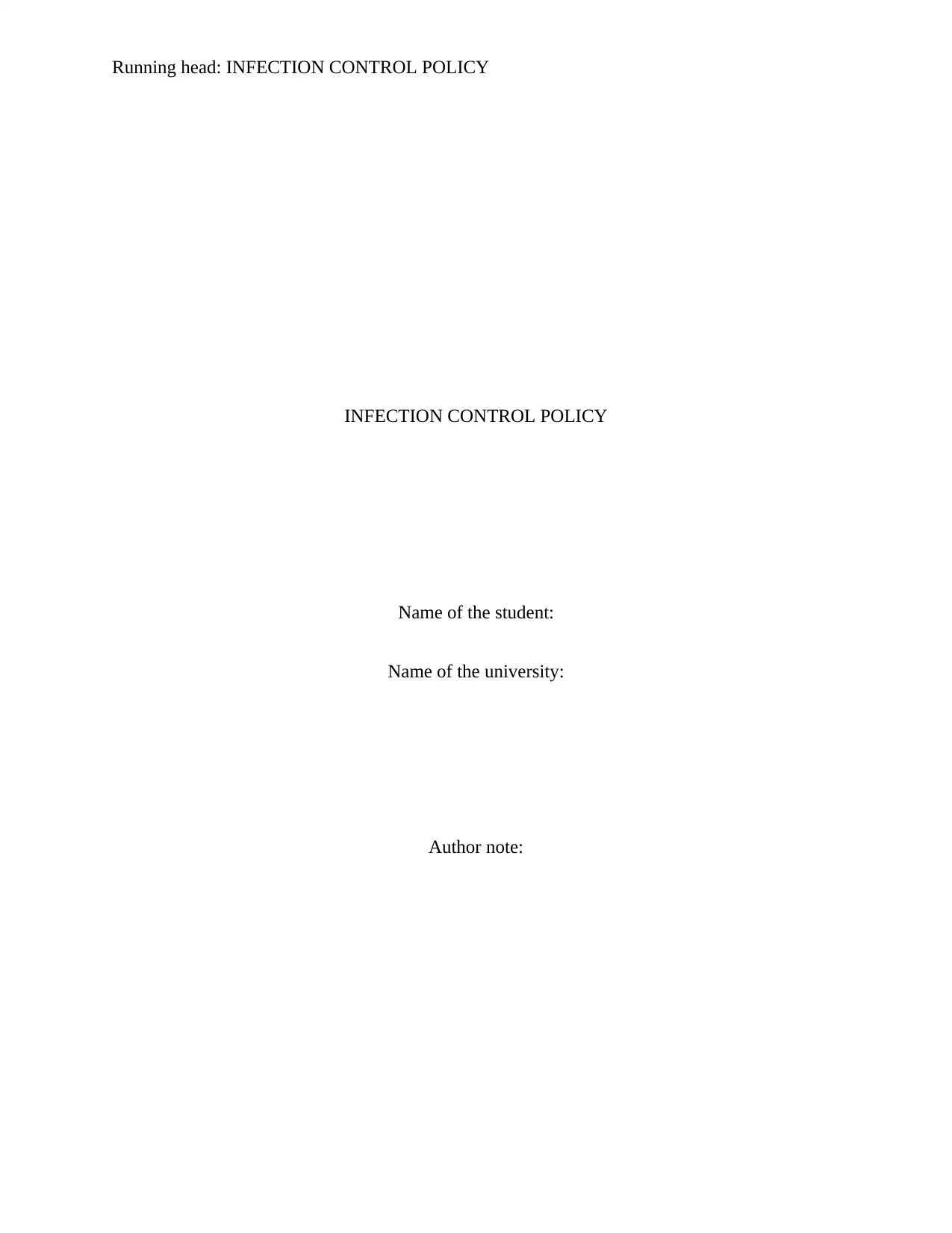
Running head: INFECTION CONTROL POLICY
INFECTION CONTROL POLICY
Name of the student:
Name of the university:
Author note:
INFECTION CONTROL POLICY
Name of the student:
Name of the university:
Author note:
Secure Best Marks with AI Grader
Need help grading? Try our AI Grader for instant feedback on your assignments.
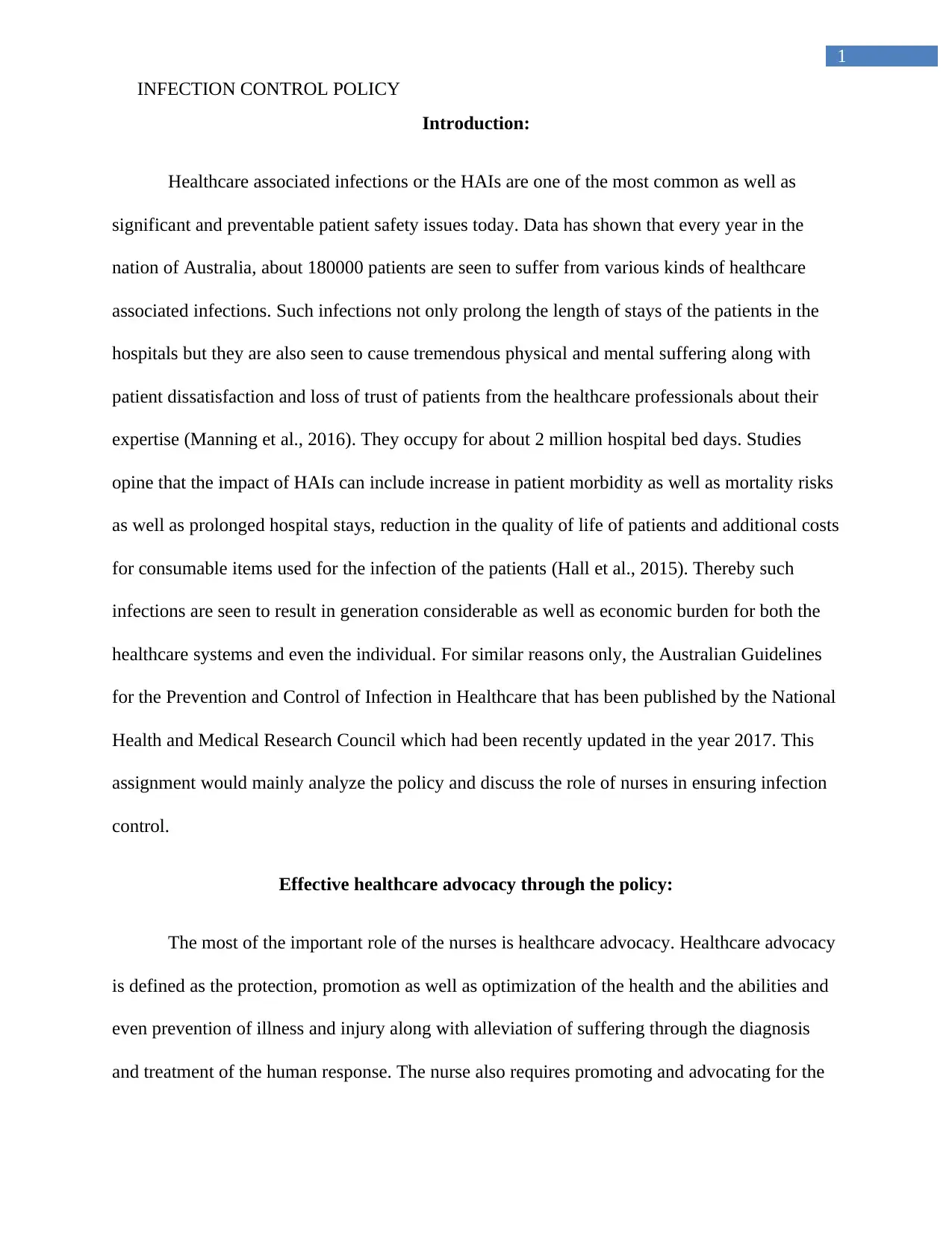
1
INFECTION CONTROL POLICY
Introduction:
Healthcare associated infections or the HAIs are one of the most common as well as
significant and preventable patient safety issues today. Data has shown that every year in the
nation of Australia, about 180000 patients are seen to suffer from various kinds of healthcare
associated infections. Such infections not only prolong the length of stays of the patients in the
hospitals but they are also seen to cause tremendous physical and mental suffering along with
patient dissatisfaction and loss of trust of patients from the healthcare professionals about their
expertise (Manning et al., 2016). They occupy for about 2 million hospital bed days. Studies
opine that the impact of HAIs can include increase in patient morbidity as well as mortality risks
as well as prolonged hospital stays, reduction in the quality of life of patients and additional costs
for consumable items used for the infection of the patients (Hall et al., 2015). Thereby such
infections are seen to result in generation considerable as well as economic burden for both the
healthcare systems and even the individual. For similar reasons only, the Australian Guidelines
for the Prevention and Control of Infection in Healthcare that has been published by the National
Health and Medical Research Council which had been recently updated in the year 2017. This
assignment would mainly analyze the policy and discuss the role of nurses in ensuring infection
control.
Effective healthcare advocacy through the policy:
The most of the important role of the nurses is healthcare advocacy. Healthcare advocacy
is defined as the protection, promotion as well as optimization of the health and the abilities and
even prevention of illness and injury along with alleviation of suffering through the diagnosis
and treatment of the human response. The nurse also requires promoting and advocating for the
INFECTION CONTROL POLICY
Introduction:
Healthcare associated infections or the HAIs are one of the most common as well as
significant and preventable patient safety issues today. Data has shown that every year in the
nation of Australia, about 180000 patients are seen to suffer from various kinds of healthcare
associated infections. Such infections not only prolong the length of stays of the patients in the
hospitals but they are also seen to cause tremendous physical and mental suffering along with
patient dissatisfaction and loss of trust of patients from the healthcare professionals about their
expertise (Manning et al., 2016). They occupy for about 2 million hospital bed days. Studies
opine that the impact of HAIs can include increase in patient morbidity as well as mortality risks
as well as prolonged hospital stays, reduction in the quality of life of patients and additional costs
for consumable items used for the infection of the patients (Hall et al., 2015). Thereby such
infections are seen to result in generation considerable as well as economic burden for both the
healthcare systems and even the individual. For similar reasons only, the Australian Guidelines
for the Prevention and Control of Infection in Healthcare that has been published by the National
Health and Medical Research Council which had been recently updated in the year 2017. This
assignment would mainly analyze the policy and discuss the role of nurses in ensuring infection
control.
Effective healthcare advocacy through the policy:
The most of the important role of the nurses is healthcare advocacy. Healthcare advocacy
is defined as the protection, promotion as well as optimization of the health and the abilities and
even prevention of illness and injury along with alleviation of suffering through the diagnosis
and treatment of the human response. The nurse also requires promoting and advocating for the
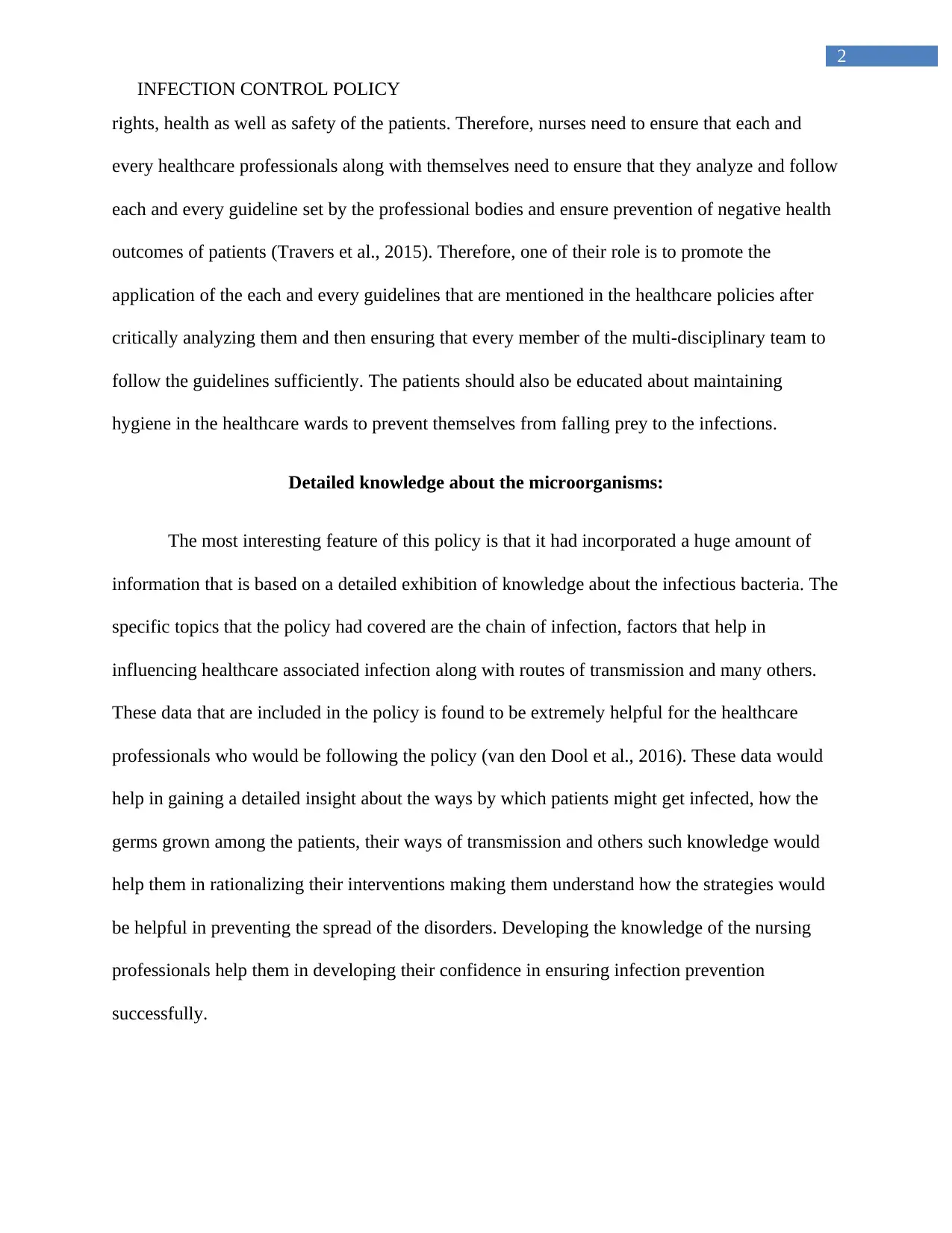
2
INFECTION CONTROL POLICY
rights, health as well as safety of the patients. Therefore, nurses need to ensure that each and
every healthcare professionals along with themselves need to ensure that they analyze and follow
each and every guideline set by the professional bodies and ensure prevention of negative health
outcomes of patients (Travers et al., 2015). Therefore, one of their role is to promote the
application of the each and every guidelines that are mentioned in the healthcare policies after
critically analyzing them and then ensuring that every member of the multi-disciplinary team to
follow the guidelines sufficiently. The patients should also be educated about maintaining
hygiene in the healthcare wards to prevent themselves from falling prey to the infections.
Detailed knowledge about the microorganisms:
The most interesting feature of this policy is that it had incorporated a huge amount of
information that is based on a detailed exhibition of knowledge about the infectious bacteria. The
specific topics that the policy had covered are the chain of infection, factors that help in
influencing healthcare associated infection along with routes of transmission and many others.
These data that are included in the policy is found to be extremely helpful for the healthcare
professionals who would be following the policy (van den Dool et al., 2016). These data would
help in gaining a detailed insight about the ways by which patients might get infected, how the
germs grown among the patients, their ways of transmission and others such knowledge would
help them in rationalizing their interventions making them understand how the strategies would
be helpful in preventing the spread of the disorders. Developing the knowledge of the nursing
professionals help them in developing their confidence in ensuring infection prevention
successfully.
INFECTION CONTROL POLICY
rights, health as well as safety of the patients. Therefore, nurses need to ensure that each and
every healthcare professionals along with themselves need to ensure that they analyze and follow
each and every guideline set by the professional bodies and ensure prevention of negative health
outcomes of patients (Travers et al., 2015). Therefore, one of their role is to promote the
application of the each and every guidelines that are mentioned in the healthcare policies after
critically analyzing them and then ensuring that every member of the multi-disciplinary team to
follow the guidelines sufficiently. The patients should also be educated about maintaining
hygiene in the healthcare wards to prevent themselves from falling prey to the infections.
Detailed knowledge about the microorganisms:
The most interesting feature of this policy is that it had incorporated a huge amount of
information that is based on a detailed exhibition of knowledge about the infectious bacteria. The
specific topics that the policy had covered are the chain of infection, factors that help in
influencing healthcare associated infection along with routes of transmission and many others.
These data that are included in the policy is found to be extremely helpful for the healthcare
professionals who would be following the policy (van den Dool et al., 2016). These data would
help in gaining a detailed insight about the ways by which patients might get infected, how the
germs grown among the patients, their ways of transmission and others such knowledge would
help them in rationalizing their interventions making them understand how the strategies would
be helpful in preventing the spread of the disorders. Developing the knowledge of the nursing
professionals help them in developing their confidence in ensuring infection prevention
successfully.
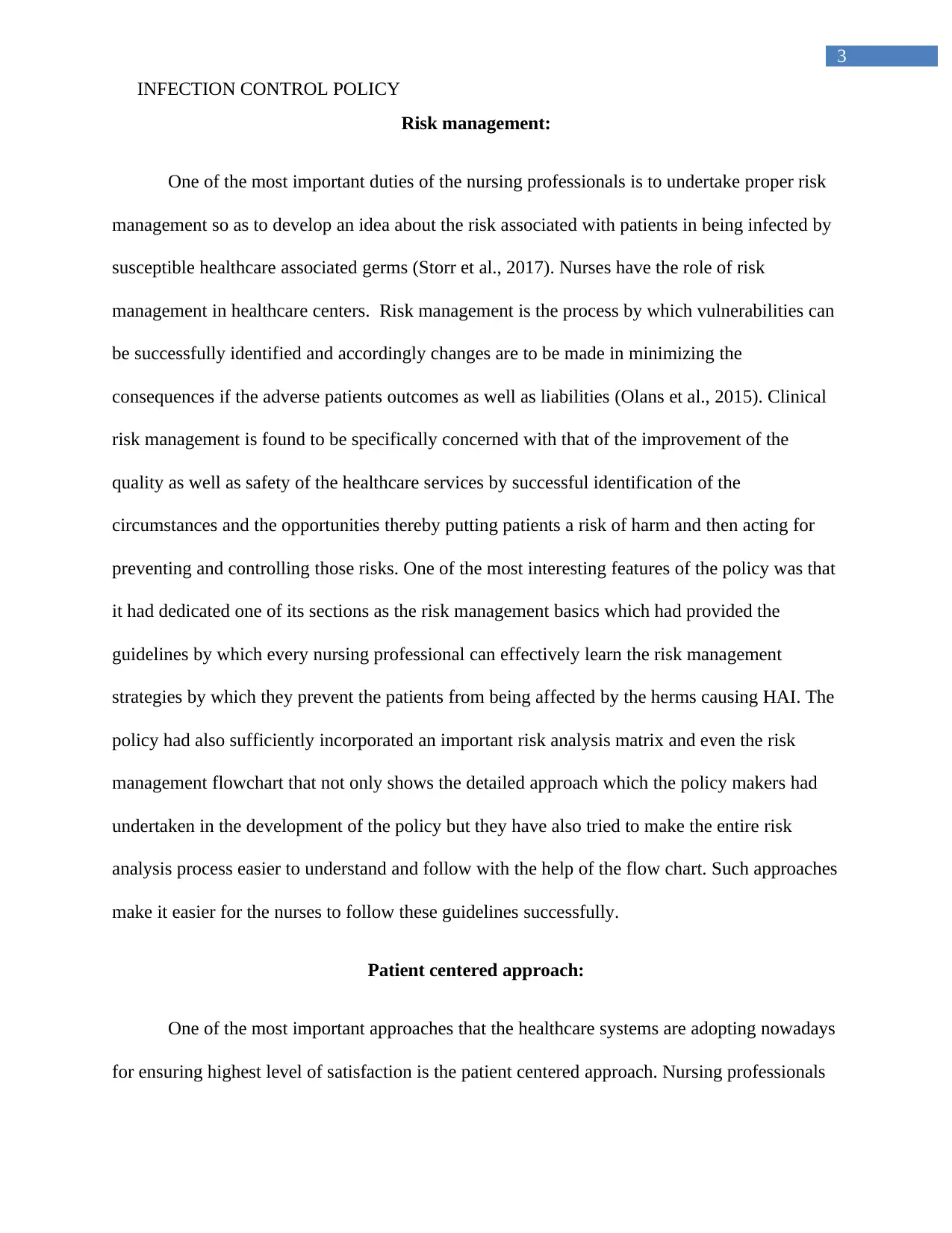
3
INFECTION CONTROL POLICY
Risk management:
One of the most important duties of the nursing professionals is to undertake proper risk
management so as to develop an idea about the risk associated with patients in being infected by
susceptible healthcare associated germs (Storr et al., 2017). Nurses have the role of risk
management in healthcare centers. Risk management is the process by which vulnerabilities can
be successfully identified and accordingly changes are to be made in minimizing the
consequences if the adverse patients outcomes as well as liabilities (Olans et al., 2015). Clinical
risk management is found to be specifically concerned with that of the improvement of the
quality as well as safety of the healthcare services by successful identification of the
circumstances and the opportunities thereby putting patients a risk of harm and then acting for
preventing and controlling those risks. One of the most interesting features of the policy was that
it had dedicated one of its sections as the risk management basics which had provided the
guidelines by which every nursing professional can effectively learn the risk management
strategies by which they prevent the patients from being affected by the herms causing HAI. The
policy had also sufficiently incorporated an important risk analysis matrix and even the risk
management flowchart that not only shows the detailed approach which the policy makers had
undertaken in the development of the policy but they have also tried to make the entire risk
analysis process easier to understand and follow with the help of the flow chart. Such approaches
make it easier for the nurses to follow these guidelines successfully.
Patient centered approach:
One of the most important approaches that the healthcare systems are adopting nowadays
for ensuring highest level of satisfaction is the patient centered approach. Nursing professionals
INFECTION CONTROL POLICY
Risk management:
One of the most important duties of the nursing professionals is to undertake proper risk
management so as to develop an idea about the risk associated with patients in being infected by
susceptible healthcare associated germs (Storr et al., 2017). Nurses have the role of risk
management in healthcare centers. Risk management is the process by which vulnerabilities can
be successfully identified and accordingly changes are to be made in minimizing the
consequences if the adverse patients outcomes as well as liabilities (Olans et al., 2015). Clinical
risk management is found to be specifically concerned with that of the improvement of the
quality as well as safety of the healthcare services by successful identification of the
circumstances and the opportunities thereby putting patients a risk of harm and then acting for
preventing and controlling those risks. One of the most interesting features of the policy was that
it had dedicated one of its sections as the risk management basics which had provided the
guidelines by which every nursing professional can effectively learn the risk management
strategies by which they prevent the patients from being affected by the herms causing HAI. The
policy had also sufficiently incorporated an important risk analysis matrix and even the risk
management flowchart that not only shows the detailed approach which the policy makers had
undertaken in the development of the policy but they have also tried to make the entire risk
analysis process easier to understand and follow with the help of the flow chart. Such approaches
make it easier for the nurses to follow these guidelines successfully.
Patient centered approach:
One of the most important approaches that the healthcare systems are adopting nowadays
for ensuring highest level of satisfaction is the patient centered approach. Nursing professionals
Secure Best Marks with AI Grader
Need help grading? Try our AI Grader for instant feedback on your assignments.
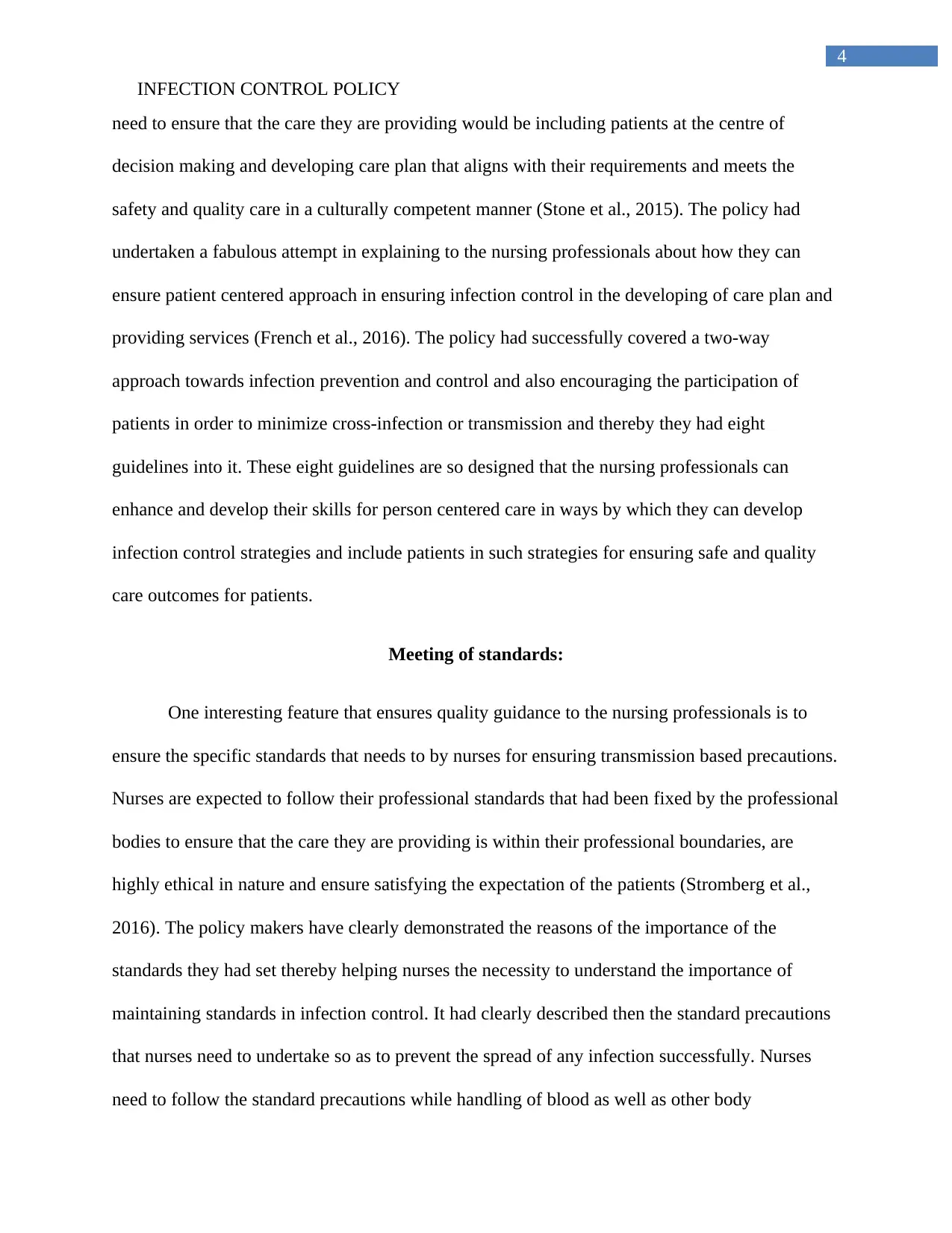
4
INFECTION CONTROL POLICY
need to ensure that the care they are providing would be including patients at the centre of
decision making and developing care plan that aligns with their requirements and meets the
safety and quality care in a culturally competent manner (Stone et al., 2015). The policy had
undertaken a fabulous attempt in explaining to the nursing professionals about how they can
ensure patient centered approach in ensuring infection control in the developing of care plan and
providing services (French et al., 2016). The policy had successfully covered a two-way
approach towards infection prevention and control and also encouraging the participation of
patients in order to minimize cross-infection or transmission and thereby they had eight
guidelines into it. These eight guidelines are so designed that the nursing professionals can
enhance and develop their skills for person centered care in ways by which they can develop
infection control strategies and include patients in such strategies for ensuring safe and quality
care outcomes for patients.
Meeting of standards:
One interesting feature that ensures quality guidance to the nursing professionals is to
ensure the specific standards that needs to by nurses for ensuring transmission based precautions.
Nurses are expected to follow their professional standards that had been fixed by the professional
bodies to ensure that the care they are providing is within their professional boundaries, are
highly ethical in nature and ensure satisfying the expectation of the patients (Stromberg et al.,
2016). The policy makers have clearly demonstrated the reasons of the importance of the
standards they had set thereby helping nurses the necessity to understand the importance of
maintaining standards in infection control. It had clearly described then the standard precautions
that nurses need to undertake so as to prevent the spread of any infection successfully. Nurses
need to follow the standard precautions while handling of blood as well as other body
INFECTION CONTROL POLICY
need to ensure that the care they are providing would be including patients at the centre of
decision making and developing care plan that aligns with their requirements and meets the
safety and quality care in a culturally competent manner (Stone et al., 2015). The policy had
undertaken a fabulous attempt in explaining to the nursing professionals about how they can
ensure patient centered approach in ensuring infection control in the developing of care plan and
providing services (French et al., 2016). The policy had successfully covered a two-way
approach towards infection prevention and control and also encouraging the participation of
patients in order to minimize cross-infection or transmission and thereby they had eight
guidelines into it. These eight guidelines are so designed that the nursing professionals can
enhance and develop their skills for person centered care in ways by which they can develop
infection control strategies and include patients in such strategies for ensuring safe and quality
care outcomes for patients.
Meeting of standards:
One interesting feature that ensures quality guidance to the nursing professionals is to
ensure the specific standards that needs to by nurses for ensuring transmission based precautions.
Nurses are expected to follow their professional standards that had been fixed by the professional
bodies to ensure that the care they are providing is within their professional boundaries, are
highly ethical in nature and ensure satisfying the expectation of the patients (Stromberg et al.,
2016). The policy makers have clearly demonstrated the reasons of the importance of the
standards they had set thereby helping nurses the necessity to understand the importance of
maintaining standards in infection control. It had clearly described then the standard precautions
that nurses need to undertake so as to prevent the spread of any infection successfully. Nurses
need to follow the standard precautions while handling of blood as well as other body
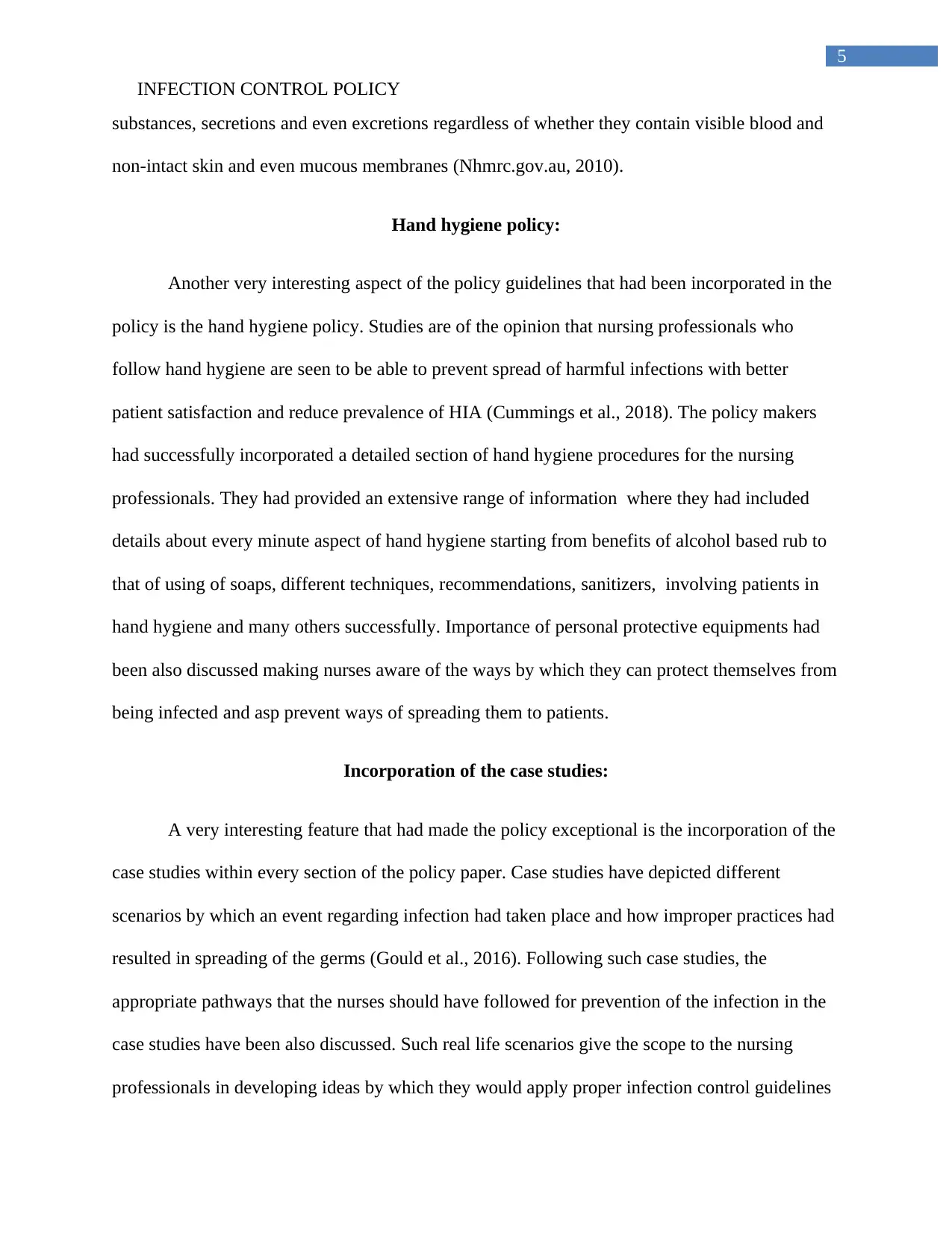
5
INFECTION CONTROL POLICY
substances, secretions and even excretions regardless of whether they contain visible blood and
non-intact skin and even mucous membranes (Nhmrc.gov.au, 2010).
Hand hygiene policy:
Another very interesting aspect of the policy guidelines that had been incorporated in the
policy is the hand hygiene policy. Studies are of the opinion that nursing professionals who
follow hand hygiene are seen to be able to prevent spread of harmful infections with better
patient satisfaction and reduce prevalence of HIA (Cummings et al., 2018). The policy makers
had successfully incorporated a detailed section of hand hygiene procedures for the nursing
professionals. They had provided an extensive range of information where they had included
details about every minute aspect of hand hygiene starting from benefits of alcohol based rub to
that of using of soaps, different techniques, recommendations, sanitizers, involving patients in
hand hygiene and many others successfully. Importance of personal protective equipments had
been also discussed making nurses aware of the ways by which they can protect themselves from
being infected and asp prevent ways of spreading them to patients.
Incorporation of the case studies:
A very interesting feature that had made the policy exceptional is the incorporation of the
case studies within every section of the policy paper. Case studies have depicted different
scenarios by which an event regarding infection had taken place and how improper practices had
resulted in spreading of the germs (Gould et al., 2016). Following such case studies, the
appropriate pathways that the nurses should have followed for prevention of the infection in the
case studies have been also discussed. Such real life scenarios give the scope to the nursing
professionals in developing ideas by which they would apply proper infection control guidelines
INFECTION CONTROL POLICY
substances, secretions and even excretions regardless of whether they contain visible blood and
non-intact skin and even mucous membranes (Nhmrc.gov.au, 2010).
Hand hygiene policy:
Another very interesting aspect of the policy guidelines that had been incorporated in the
policy is the hand hygiene policy. Studies are of the opinion that nursing professionals who
follow hand hygiene are seen to be able to prevent spread of harmful infections with better
patient satisfaction and reduce prevalence of HIA (Cummings et al., 2018). The policy makers
had successfully incorporated a detailed section of hand hygiene procedures for the nursing
professionals. They had provided an extensive range of information where they had included
details about every minute aspect of hand hygiene starting from benefits of alcohol based rub to
that of using of soaps, different techniques, recommendations, sanitizers, involving patients in
hand hygiene and many others successfully. Importance of personal protective equipments had
been also discussed making nurses aware of the ways by which they can protect themselves from
being infected and asp prevent ways of spreading them to patients.
Incorporation of the case studies:
A very interesting feature that had made the policy exceptional is the incorporation of the
case studies within every section of the policy paper. Case studies have depicted different
scenarios by which an event regarding infection had taken place and how improper practices had
resulted in spreading of the germs (Gould et al., 2016). Following such case studies, the
appropriate pathways that the nurses should have followed for prevention of the infection in the
case studies have been also discussed. Such real life scenarios give the scope to the nursing
professionals in developing ideas by which they would apply proper infection control guidelines
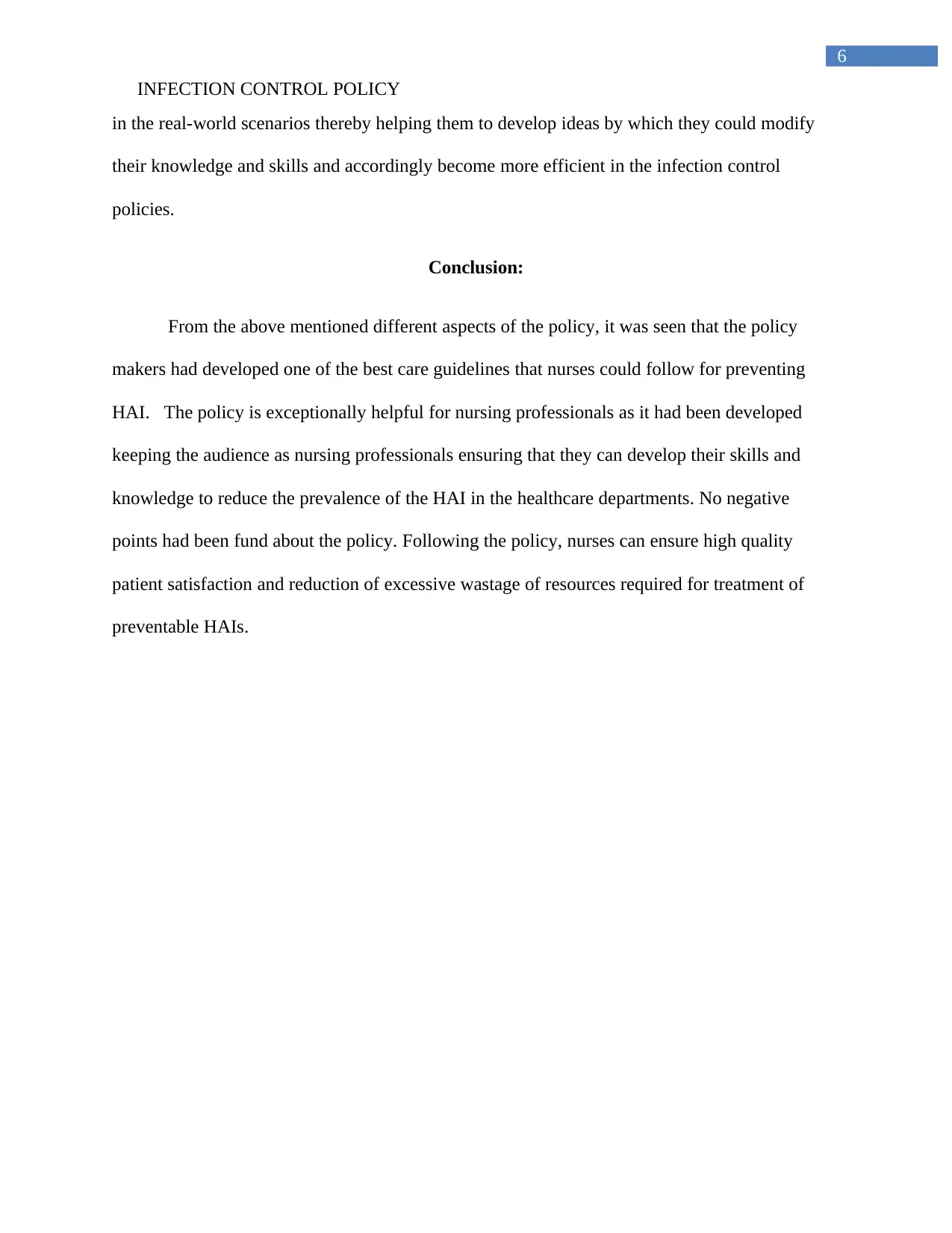
6
INFECTION CONTROL POLICY
in the real-world scenarios thereby helping them to develop ideas by which they could modify
their knowledge and skills and accordingly become more efficient in the infection control
policies.
Conclusion:
From the above mentioned different aspects of the policy, it was seen that the policy
makers had developed one of the best care guidelines that nurses could follow for preventing
HAI. The policy is exceptionally helpful for nursing professionals as it had been developed
keeping the audience as nursing professionals ensuring that they can develop their skills and
knowledge to reduce the prevalence of the HAI in the healthcare departments. No negative
points had been fund about the policy. Following the policy, nurses can ensure high quality
patient satisfaction and reduction of excessive wastage of resources required for treatment of
preventable HAIs.
INFECTION CONTROL POLICY
in the real-world scenarios thereby helping them to develop ideas by which they could modify
their knowledge and skills and accordingly become more efficient in the infection control
policies.
Conclusion:
From the above mentioned different aspects of the policy, it was seen that the policy
makers had developed one of the best care guidelines that nurses could follow for preventing
HAI. The policy is exceptionally helpful for nursing professionals as it had been developed
keeping the audience as nursing professionals ensuring that they can develop their skills and
knowledge to reduce the prevalence of the HAI in the healthcare departments. No negative
points had been fund about the policy. Following the policy, nurses can ensure high quality
patient satisfaction and reduction of excessive wastage of resources required for treatment of
preventable HAIs.
Paraphrase This Document
Need a fresh take? Get an instant paraphrase of this document with our AI Paraphraser
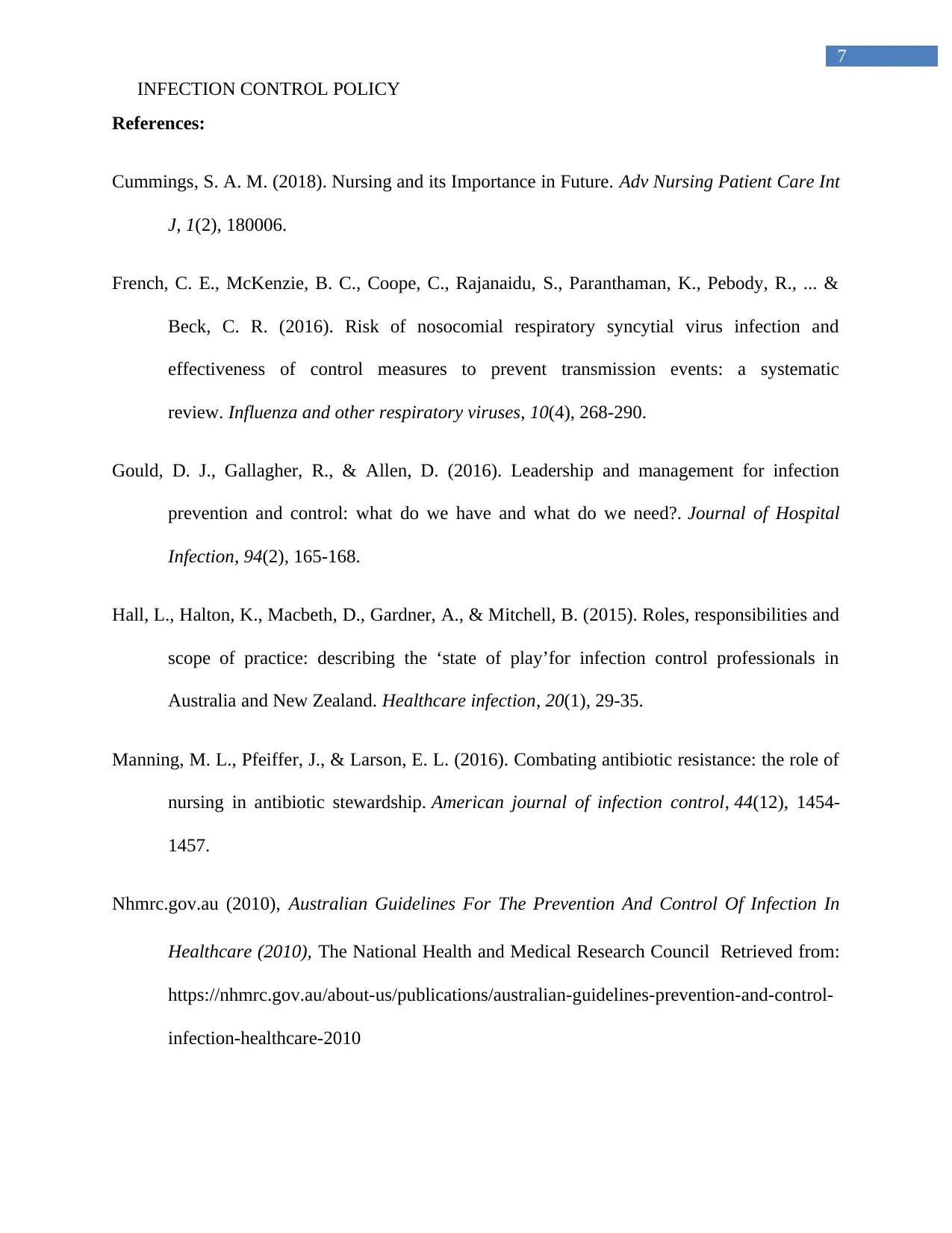
7
INFECTION CONTROL POLICY
References:
Cummings, S. A. M. (2018). Nursing and its Importance in Future. Adv Nursing Patient Care Int
J, 1(2), 180006.
French, C. E., McKenzie, B. C., Coope, C., Rajanaidu, S., Paranthaman, K., Pebody, R., ... &
Beck, C. R. (2016). Risk of nosocomial respiratory syncytial virus infection and
effectiveness of control measures to prevent transmission events: a systematic
review. Influenza and other respiratory viruses, 10(4), 268-290.
Gould, D. J., Gallagher, R., & Allen, D. (2016). Leadership and management for infection
prevention and control: what do we have and what do we need?. Journal of Hospital
Infection, 94(2), 165-168.
Hall, L., Halton, K., Macbeth, D., Gardner, A., & Mitchell, B. (2015). Roles, responsibilities and
scope of practice: describing the ‘state of play’for infection control professionals in
Australia and New Zealand. Healthcare infection, 20(1), 29-35.
Manning, M. L., Pfeiffer, J., & Larson, E. L. (2016). Combating antibiotic resistance: the role of
nursing in antibiotic stewardship. American journal of infection control, 44(12), 1454-
1457.
Nhmrc.gov.au (2010), Australian Guidelines For The Prevention And Control Of Infection In
Healthcare (2010), The National Health and Medical Research Council Retrieved from:
https://nhmrc.gov.au/about-us/publications/australian-guidelines-prevention-and-control-
infection-healthcare-2010
INFECTION CONTROL POLICY
References:
Cummings, S. A. M. (2018). Nursing and its Importance in Future. Adv Nursing Patient Care Int
J, 1(2), 180006.
French, C. E., McKenzie, B. C., Coope, C., Rajanaidu, S., Paranthaman, K., Pebody, R., ... &
Beck, C. R. (2016). Risk of nosocomial respiratory syncytial virus infection and
effectiveness of control measures to prevent transmission events: a systematic
review. Influenza and other respiratory viruses, 10(4), 268-290.
Gould, D. J., Gallagher, R., & Allen, D. (2016). Leadership and management for infection
prevention and control: what do we have and what do we need?. Journal of Hospital
Infection, 94(2), 165-168.
Hall, L., Halton, K., Macbeth, D., Gardner, A., & Mitchell, B. (2015). Roles, responsibilities and
scope of practice: describing the ‘state of play’for infection control professionals in
Australia and New Zealand. Healthcare infection, 20(1), 29-35.
Manning, M. L., Pfeiffer, J., & Larson, E. L. (2016). Combating antibiotic resistance: the role of
nursing in antibiotic stewardship. American journal of infection control, 44(12), 1454-
1457.
Nhmrc.gov.au (2010), Australian Guidelines For The Prevention And Control Of Infection In
Healthcare (2010), The National Health and Medical Research Council Retrieved from:
https://nhmrc.gov.au/about-us/publications/australian-guidelines-prevention-and-control-
infection-healthcare-2010
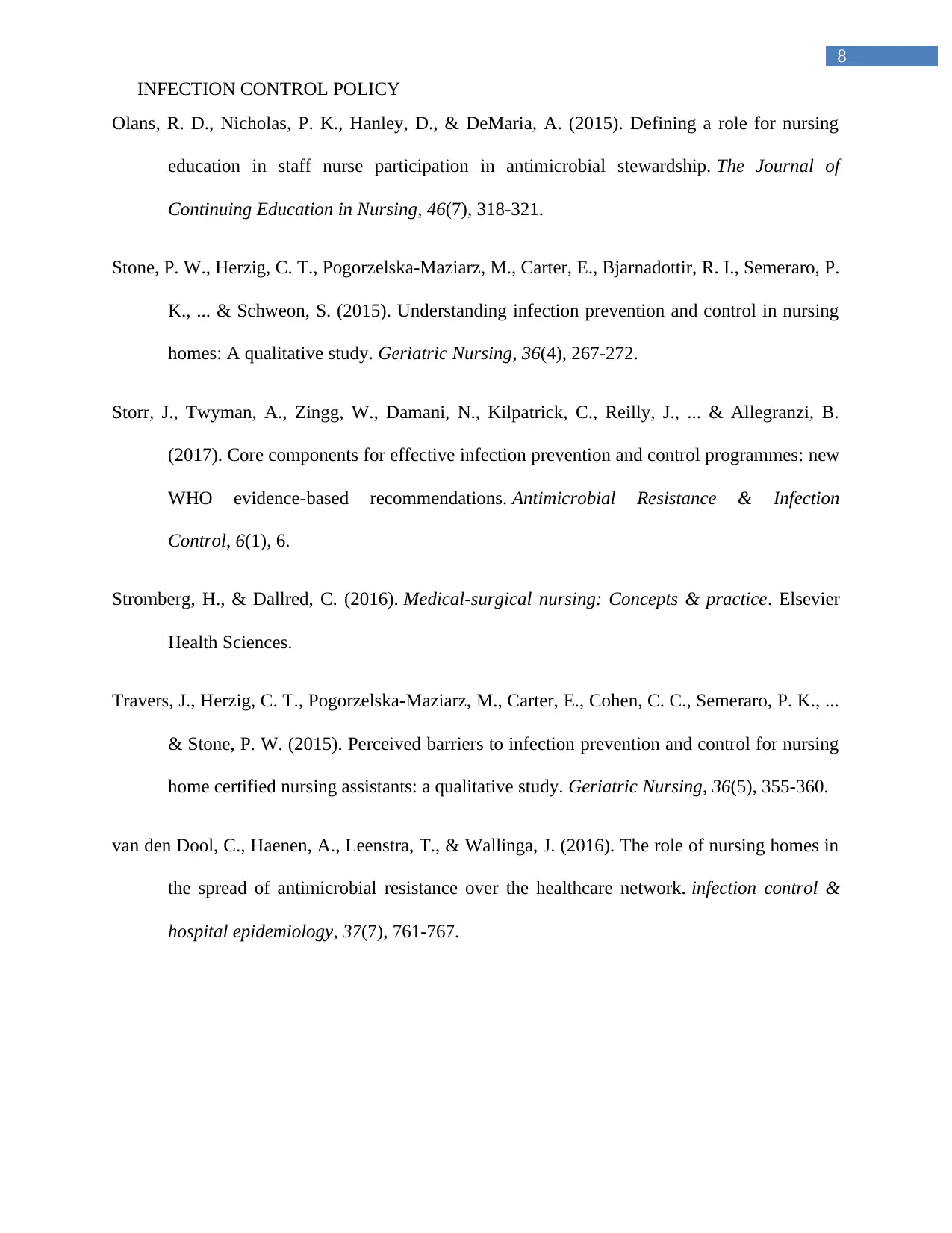
8
INFECTION CONTROL POLICY
Olans, R. D., Nicholas, P. K., Hanley, D., & DeMaria, A. (2015). Defining a role for nursing
education in staff nurse participation in antimicrobial stewardship. The Journal of
Continuing Education in Nursing, 46(7), 318-321.
Stone, P. W., Herzig, C. T., Pogorzelska-Maziarz, M., Carter, E., Bjarnadottir, R. I., Semeraro, P.
K., ... & Schweon, S. (2015). Understanding infection prevention and control in nursing
homes: A qualitative study. Geriatric Nursing, 36(4), 267-272.
Storr, J., Twyman, A., Zingg, W., Damani, N., Kilpatrick, C., Reilly, J., ... & Allegranzi, B.
(2017). Core components for effective infection prevention and control programmes: new
WHO evidence-based recommendations. Antimicrobial Resistance & Infection
Control, 6(1), 6.
Stromberg, H., & Dallred, C. (2016). Medical-surgical nursing: Concepts & practice. Elsevier
Health Sciences.
Travers, J., Herzig, C. T., Pogorzelska-Maziarz, M., Carter, E., Cohen, C. C., Semeraro, P. K., ...
& Stone, P. W. (2015). Perceived barriers to infection prevention and control for nursing
home certified nursing assistants: a qualitative study. Geriatric Nursing, 36(5), 355-360.
van den Dool, C., Haenen, A., Leenstra, T., & Wallinga, J. (2016). The role of nursing homes in
the spread of antimicrobial resistance over the healthcare network. infection control &
hospital epidemiology, 37(7), 761-767.
INFECTION CONTROL POLICY
Olans, R. D., Nicholas, P. K., Hanley, D., & DeMaria, A. (2015). Defining a role for nursing
education in staff nurse participation in antimicrobial stewardship. The Journal of
Continuing Education in Nursing, 46(7), 318-321.
Stone, P. W., Herzig, C. T., Pogorzelska-Maziarz, M., Carter, E., Bjarnadottir, R. I., Semeraro, P.
K., ... & Schweon, S. (2015). Understanding infection prevention and control in nursing
homes: A qualitative study. Geriatric Nursing, 36(4), 267-272.
Storr, J., Twyman, A., Zingg, W., Damani, N., Kilpatrick, C., Reilly, J., ... & Allegranzi, B.
(2017). Core components for effective infection prevention and control programmes: new
WHO evidence-based recommendations. Antimicrobial Resistance & Infection
Control, 6(1), 6.
Stromberg, H., & Dallred, C. (2016). Medical-surgical nursing: Concepts & practice. Elsevier
Health Sciences.
Travers, J., Herzig, C. T., Pogorzelska-Maziarz, M., Carter, E., Cohen, C. C., Semeraro, P. K., ...
& Stone, P. W. (2015). Perceived barriers to infection prevention and control for nursing
home certified nursing assistants: a qualitative study. Geriatric Nursing, 36(5), 355-360.
van den Dool, C., Haenen, A., Leenstra, T., & Wallinga, J. (2016). The role of nursing homes in
the spread of antimicrobial resistance over the healthcare network. infection control &
hospital epidemiology, 37(7), 761-767.
1 out of 9
Related Documents
Your All-in-One AI-Powered Toolkit for Academic Success.
+13062052269
info@desklib.com
Available 24*7 on WhatsApp / Email
![[object Object]](/_next/static/media/star-bottom.7253800d.svg)
Unlock your academic potential
© 2024 | Zucol Services PVT LTD | All rights reserved.





